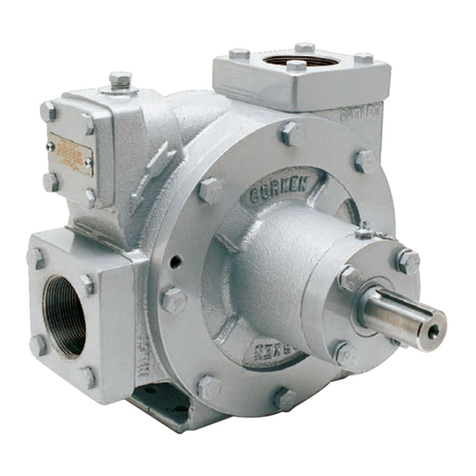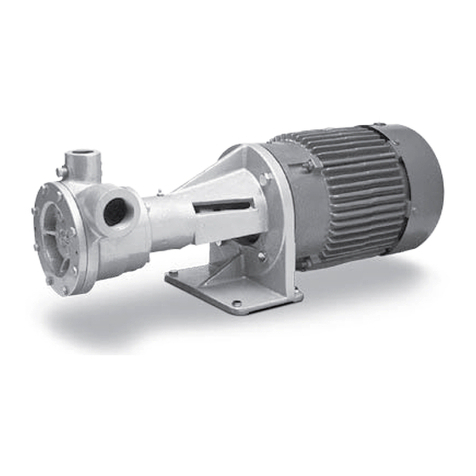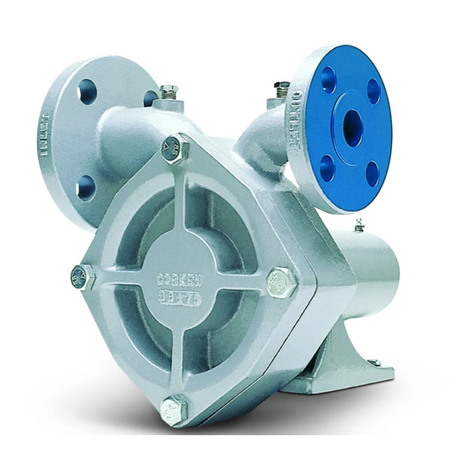
Chapter 1—Installation (Truck)
The mechanical installation of the PT-Series pump is a
simple matter. A rotation arrow is located on the side of
the pump. Examine the PTO and determine the direction
of its rotation before installing the pump. The PT-Series
pump will match either PTO rotation. Connect the drive
shaft to the pump shaft that turns the pump in the
direction of the arrow.
The PTO SELECTION is important. For maximum
performance, the pump requires a PTO with an average
output speed of 500 to 700 RPM. In addition, the truck
engine must be operating at the appropriate RPM
to maintain oil pressure, water circulation, and the
electrical system.
THE DRIVESHAFT that connects the pump to the PTO
should be of the “splined” or slip type. This type of
driveshaft permits the shaft to adjust for PTO movement
and twisting of the truck frame. A fixed driveshaft will
transfer the forces directly to the pump and PTO and
shorten the life of both considerably. The yokes of the
driveshaft universal joints must be positioned as shown
in Figure 1. Improper positioning will cause premature
wear and potentially destroy the bearings in the pump
and PTO.
INLET PIPING should be as short as possible and at least
the minimum diameter specified for the model with few
restrictions so that the pressure drop is limited.
The outlet piping should include the following:
1. A pressure gauge should be installed in the pump
outlet or near it. A pressure gauge is necessary to
determine the efficiency of the pumping system.
2. If a meter with an air eliminator is installed, never pipe
the eliminator directly into the pump inlet piping or
into the liquid part of the system at any point (refer to
the meter installation manual).
3. The discharge piping should be at least the same size
as the meter piping.
1.1 Power Take-Off Drive Systems
Proper pump operation and long life is directly dependent
upon a good drive system. Many truck pumps utilize
a power train consisting of shafts and universal joints
located between the power take-off shaft of the truck
engine and the pump.
There are several basic principles that should be followed
in designing a PTO drive. To produce a workable power
train that results in long pump life and reduced drive
wear, these principles should not be violated.
First, the driver shaft and the driven shaft must be parallel
to one another within plus or minus one degree. Improper
alignment will cause jerking and back and forth “whip”
to the pump shaft; thereby imparting a surging pulsation
to the liquid flow which results in noise, vibration and
abnormal wear.
Second, the angle of the “floating” shaft should be within
the limits for the particular equipment being used (usually
a maximum of 15° at pump speeds up to 800 RPM). To
ensure that shaft expansion or contraction does not
distort the drive system, a splined slip joint should be
placed between the two universal joints. Again, the drive
shaft should be of the “splined” or slip type to permit
the shaft to adjust for PTO movement and twisting of
the truck frame. A fixed drive shaft transmits the forces
directly to the pump and PTO which will shorten the life
of both considerably.
Third, the yokes of the drive shaft universal joints must be
in a parallel position. Figure 1 below illustrates the proper
arrangement of the yokes.
Improperly installed U-joints will cause premature failure
of U-joints as well as bearings in the pump and PTO.
Properly mounted, the second universal gives uniform
motion to the drive shaft by compensating for the
rotational error introduced by the first U-joint. An even
number of universal joints (2, 4, 6 etc.) should always be
used. An odd number of U-joints will cause unbalanced
pump shaft rotation. This problem becomes greater with
increased angularity.
Other points to consider include the proper sizing of the
shaft components with a maximum horsepower load to
be expected, good alignment of hanger bearings and
proper pump coupling alignment.
Improper PTO systems account for a high percentage
of truck pump failures. Always remember to disengage
the clutch before shifting the PTO into gear. Shifting the
PTO into gear without disengaging the clutch imparts
an enormous shock on the PTO, drive shaft, pump and
meter and will soon damage one or all of them.
For proper installation of pump drives, follow the rules
listed below:
1. Driver shaft and pump shaft must be parallel, plus or
minus one degree.
2. Operating angle of the “floating” shaft must be 15°
maximum.
3. Universal yokes must be in line and parallel.
4. Splined slip joints must be used where needed.
5. Use an even number of universal joints.
5
































